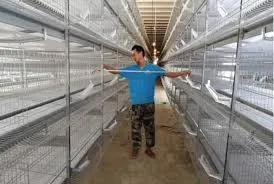chicken wire cages
Nov . 05, 2024 17:45 Back to list
chicken wire cages
The Role and Impact of Chicken Wire Cages in Poultry Farming
Chicken wire cages, often referred to simply as wire cages, have become a ubiquitous component of modern poultry farming. These structures, made from galvanized steel wire, offer a method of housing birds that is both efficient and practical. In the context of increased demand for poultry products, understanding the role and implications of chicken wire cages is crucial for farmers, consumers, and animal welfare advocates alike.
Design and Structure
Chicken wire cages are designed to maximize the space and facilitate the management of large flocks of poultry. Typically, these cages are arranged in tiers to maximize vertical space, providing a significant number of birds per square foot compared to traditional farming methods. The wire structure allows for adequate ventilation and reduces the risk of certain health issues associated with overcrowding. Importantly, the open nature of these cages allows farmers to monitor the health of the birds easily.
Moreover, the use of wire instead of solid walls provides better airflow, which is crucial in preventing heat stress during warmer weather. This design often leads to improved egg production and reduces mortality rates among the chickens, making it a preferred choice for commercial egg production.
Economic Benefits
From an economic standpoint, chicken wire cages offer numerous advantages to poultry farmers. Due to their efficiency in space usage and animal management, farmers can raise a significantly higher number of chickens in a smaller area. This high-density housing can lead to increased profitability, as farmers can meet the growing consumer demand for eggs and meat without needing to acquire more land. Additionally, automated feeding and watering systems can be installed in and around these cages, reducing labor costs and increasing production efficiency.
Health and Welfare Considerations
chicken wire cages

Despite their economic advantages, chicken wire cages have come under scrutiny concerning animal welfare. Critics argue that the confinement of birds in wire cages restricts their natural behaviors, such as nesting, foraging, and dust bathing. In response to growing consumer demand for humane treatment of animals, some countries have begun to implement stricter regulations on cage size and conditions.
Enriched cages, which provide additional space and various structures to mimic natural environments, have emerged as a compromise between conventional wire cages and free-range farming. These enriched systems allow birds some freedom to move and engage in natural behaviors while maintaining the efficiency of cage farming.
Environmental Considerations
The use of chicken wire cages also has implications for environmental sustainability. Concentrated poultry farming can lead to significant waste production, which, if not managed properly, can result in pollution of local water supplies and contribute to greenhouse gas emissions. However, the efficiency of cage systems can potentially minimize land usage and reduce the carbon footprint associated with feed production and waste management when compared to traditional pasture-raised systems.
As the global population continues to grow, the demand for affordable protein sources like chicken will likely increase. This reality necessitates a balanced approach that considers economic viability, animal welfare, and environmental sustainability.
Conclusion
In conclusion, chicken wire cages play a vital role in the modern poultry industry, providing essential benefits in terms of efficiency and production capacity. However, ongoing debates surrounding animal welfare and environmental sustainability pose significant challenges. As consumer preferences evolve and regulatory frameworks tighten, the industry must adapt accordingly. The future may see a blend of traditional and innovative practices, ensuring that the need for production does not overshadow the importance of humane treatment and environmental stewardship. As stakeholders in the poultry industry navigate this complex landscape, the goal will remain clear to produce food responsibly, ethically, and sustainably for generations to come.
-
Hot Sale 24 & 18 Door Rabbit Cages - Premium Breeding Solutions
NewsJul.25,2025
-
Automatic Feeding Line System Pan Feeder Nipple Drinker - Anping County Yize Metal Products Co., Ltd.
NewsJul.21,2025
-
Automatic Feeding Line System Pan Feeder Nipple Drinker - Anping County Yize Metal Products Co., Ltd.
NewsJul.21,2025
-
Automatic Feeding Line System - Anping Yize | Precision & Nipple
NewsJul.21,2025
-
Automatic Feeding Line System - Anping Yize | Precision & Nipple
NewsJul.21,2025
-
Automatic Feeding Line System-Anping County Yize Metal Products Co., Ltd.|Efficient Feed Distribution&Customized Animal Farming Solutions
NewsJul.21,2025






